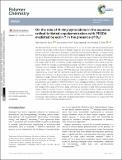On the role of -vinylpyrrolidone in the aqueous radical-initiated copolymerization with PEGDA mediated by eosin Y in the presence of O[subscript 2]
Author(s)
Aguirre Soto, Hector Alan; Kim, Seunghyeon; Kaastrup, Kaja; Sikes Johnson, Hadley
Downloadc8py01459k.pdf (1.765Mb)
PUBLISHER_CC
Publisher with Creative Commons License
Creative Commons Attribution
Terms of use
Metadata
Show full item recordAbstract
The photochemistry of eosin Y has attracted attention for its role in visible-light induced polymerization reactions that proceed in the presence of ambient oxygen to form various macromolecular architectures that are useful for a wide range of applications, including biosensing and drug delivery. N-Vinylpyrrolidone (NVP) has been employed as a comonomer in the eosin-mediated synthesis of hydrogels with polyethylene glycol (PEG) based multifunctional monomers to aid in reducing oxygen inhibition and enhancing the rate of radical polymerization and the final conversion. However, the mechanism by which NVP reduces the oxygen inhibition time (t[subscript inh]) remains unclear. Additionally, no investigations were found on the integration of NVP into the radical-generating photocatalytic mechanism of eosin Y. Towards a better understanding of eosin-mediated synthesis of PEG-based hydrogels, we analyzed the effect of NVP on the steady-state kinetics of the aqueous NVP/PEG-diacrylate copolymerization reaction. In this case, the reduction in t[subscript inh] is lower than that reported for copolymerization with neat (meth)acrylate monomers. We propose the formation of a ground-state complex between eosin and NVP as the main reason for the reduction in oxygen inhibition and contrast it with previous theories. In addition, we discuss the role of this eosin/NVP complex and cross-propagation kinetics to explain the ∼70% increase in the initial rate of polymerization upon addition of NVP. The effect of cross-propagation kinetics is enhanced at the later stages, leading to a 10% increase in final vinyl conversion in this relatively mobile network. By analyzing the change in the scaling of the eosin decay coefficient as a function of light intensity during and after oxygen inhibition, we then link eosin inactivation to radical termination kinetics. Finally, we discuss the role of radical recombination between semireduced eosin and the propagating radicals as an additional eosin inactivation route by which leuco-eosin ends tethered to the network. These insights contribute to a thorough understanding of visible-light activated polymerization in the presence of oxygen and of the role of NVP in eosin-mediated radical production.
Date issued
2018-12Department
Massachusetts Institute of Technology. Department of Chemical EngineeringJournal
Polymer Chemistry
Publisher
Royal Society of Chemistry
Citation
Aguirre-Soto, Alan, Seunghyeon Kim, Kaja Kaastrup, and Hadley D. Sikes. “On the Role of N-Vinylpyrrolidone in the Aqueous Radical-Initiated Copolymerization with PEGDA Mediated by Eosin Y in the Presence of O[subscript 2].” Polymer Chemistry (2019). © Royal Society of Chemistry
Version: Final published version
ISSN
1759-9954
1759-9962